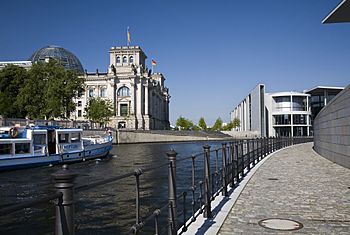Spree facts for kids
Quick facts for kids Spree/Sprjewja/Spréva |
|
|---|---|

The Spree in Berlin, Reichstag building to the left
|
|
| Country | Czech Republic, Germany |
| Physical characteristics | |
| Main source | Upper Lusatia |
| River mouth | Havel 52°32′10″N 13°12′31″E / 52.53611°N 13.20861°E |
| Length | about 400 km (250 mi) |
| Basin features | |
| Progression | Havel→ Elbe→ North Sea |
| Basin size | 10,105 km2 (3,902 sq mi) |
The Spree is a famous river in Germany. It also flows through a small part of the Czech Republic. The Spree is about 400 kilometres (250 mi) long. It is a branch of the River Havel. The Havel then flows into the Elbe River, which eventually reaches the North Sea. The Spree is very important because the old center of Berlin was built right on its banks.
The part of the river between the Dämeritzsee and Müggelsee lakes, east of Berlin, is called the Müggelspree.
Contents
Where Does the Spree River Flow?
The Spree River starts from a small pond. This pond is in the Lusatian Highlands, close to the Czech border. The river flows along the border for a short distance. It passes near the towns of Ebersbach and Oppach.
After leaving the hills, the Spree flows through Bautzen. Just north of Bautzen, it goes through the Bautzen Reservoir. Further north, the river passes through the city of Spremberg. Then it reaches the city of Cottbus.
North of Cottbus, the Spree enters the Spreewald. This is a large area of wetlands. In the Spreewald, the river flows through towns like Lübbenau, Lübben, and Leibsch.
Spree's Journey to Berlin
Below Leibsch, some water from the Spree is sent into the Dahme Flood Relief Canal. This canal helps control water levels. The Spree continues north from Leibsch. It then flows into the Neuendorfer See lake.
From this lake, the river flows east to the Schwielochsee. Then it turns north and west towards the town of Fürstenwalde. From Fürstenwalde, the Spree keeps flowing west. It passes through the Dämeritzsee and Müggelsee lakes. Finally, it reaches Köpenick in southeastern Berlin. Here, another river, the River Dahme, joins the Spree.
The Spree in Berlin City Center
The most famous part of the Spree is its final stretch. This is where it flows right through the heart of Berlin. The river joins the River Havel in Spandau. Spandau is one of Berlin’s western areas. The Havel then joins the Elbe River. The Elbe eventually reaches the sea in Cuxhaven, after flowing through Hamburg.
As the Spree goes through Berlin, it passes many famous landmarks. These include the Berlin Cathedral (Berliner Dom). It also flows past the Reichstag building and the Schloss Charlottenburg. The well-known Museum Island (Museumsinsel) is also in the Spree. This island has five major museums.
In 2004, a special floating swimming pool opened on the Spree in Berlin. It is called the Badeschiff.
How is the Spree River Used for Travel?
The Spree River is used for different types of boats. In the wetlands of the Spreewald, small boats called punts are very common.
Larger boats can travel upstream as far as Leibsch. However, the upper parts of the river are quite shallow. They are mostly used by boats for fun, not for big ships. Some parts of the river cannot be used by boats at all. Canals are built to go around these parts.
Spree's Connection to Other Waterways
For about 20 kilometres (12 mi) east of Fürstenwalde, the Spree is part of the Oder-Spree Canal. This canal is important. It helps connect Berlin to the River Oder. The Oder River then flows into Poland. The canal leaves the Spree just east of Fürstenwalde. It later joins the River Dahme at the Seddinsee lake.
In Berlin, the Spree is part of a big network of waterways. Many of these are man-made canals. This network offers many different routes for boats. Several important commercial ports are on this network. Tugboats and barges move things like sand, grain, bricks, and even beer. Tourist boats also offer frequent tours of the central Spree and its connected waterways.
Images for kids
-
Spree in Bautzen
-
Spree with Berlin Hauptbahnhof & the entrance of a canal
-
Spree in central Berlin, with Oberbaum Bridge










